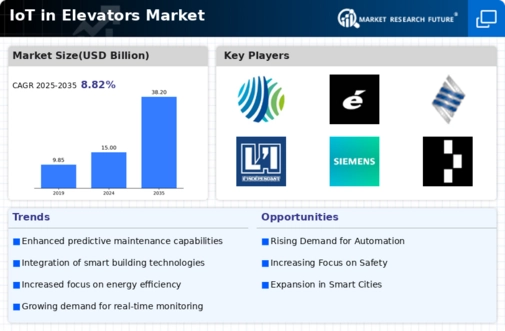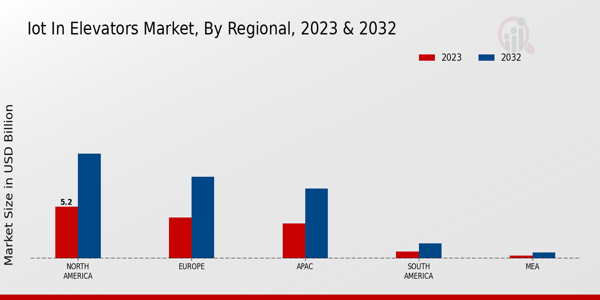There are some essential market drivers propelling growth in the IoT in Elevators Market. One of these is the rising demand for integrating smart technologies into the building environment which directly aids the acceleration of integrating IoT technologies into elevators. Increasing urbanization with an increase in the number of skyscrapers has shifted focus towards improving the experience of passengers and the efficiency of operations. Furthermore, IoT technologies are being adopted due to the necessity of real-time monitoring and predictive maintenance to decrease the chances of downtime and improve safety.
Increasing concern for sustainable practices in building infrastructure is also a key driver because IoT solutions assist in the efficient use of energy and the reduction of carbon emissions.
In this emerging market there are lots of opportunities yet to be tapped. The penetration of machine learning and AI in the elevator system will certainly improve engagement with the user, as well as provide a trigger to maintain the elevator before any issues arise. Further, IoT's concerns with older systems in antiquated buildings provide a pathway for increased modernization, which is appealing to the property owners anticipating adding value to their real estate. Further, growth and innovations can be acquired through partnerships between the IoT solution providers and those on the elevator manufacturing line.
There's am increasing migration toward elevators that are smatter due to their enhanced connectivity features.
The rising trend of contactless solutions, which are health and safety-oriented, is a result of the incorporation of IoT technologies. The integration of machine learning applications into the elevator system is making it easier to predict maintenance needs while real-time data is being deployed to improve the reliability and efficiency of elevator systems. Further, in the future, Internet of Things features of building elevators are expected to change the way this vertical transportation system operates, thereby offering greater value to both the users and the building managers.
Greater productivity and efficiency in the elevator systems are expected due to the environment of the Global IoT in the Elevator Market, which is conducive to encouraging creativity and the expansion of new and better solutions.
The IoT in Elevators Market is seeing significant growth due to several key market drivers. The rising demand for smarter and more efficient buildings contributes to the acceleration of IoT integration in elevators. As urbanization increases and the number of high-rises grows, there is a greater focus on enhancing passenger experiences and operational efficiency. Additionally, the need for real-time monitoring and predictive maintenance is driving the adoption of IoT technologies, enabling building managers to reduce downtime and improve safety.
The push for sustainability in urban infrastructure is also a major factor, as IoT solutions help in optimizing energy consumption and minimizing carbon footprints.
There are ample opportunities to be explored in this evolving market. The development of advanced analytics and artificial intelligence can lead to more innovative elevator systems, allowing for personalized user experiences and proactive maintenance alerts. Integrating IoT with existing systems in outdated buildings offers a pathway for modernization, making it attractive for property owners looking to enhance their asset value. Moreover, collaborations between IoT solution providers and elevator manufacturers can unlock new avenues for growth and innovation. Recent trends show an increased shift towards smart elevators that leverage advanced connectivity features.
The implementation of IoT technologies is resulting in the rise of contactless solutions, which have gained prominence in response to health and safety concerns. Real-time data is now being utilized to enhance the efficiency and reliability of elevator systems, while machine learning applications are helping to forecast maintenance needs. As technology continues to evolve, the integration of IoT features in the elevator sector is anticipated to reshape how these systems operate, providing significant benefits to users and building managers alike.
Overall, the landscape of the IoT in Elevators Market is rapidly changing, paving the way for more innovative, efficient, and user-friendly solutions.
Figure 1:IoT in Elevators Market, 2025 - 2034
Source: Primary Research, Secondary Research, Market Research Future Database and Analyst Review
The integration of IoT technologies in elevators is poised to enhance operational efficiency and user experience, reflecting a broader trend towards smart infrastructure in urban environments.
U.S. Department of Energy
























